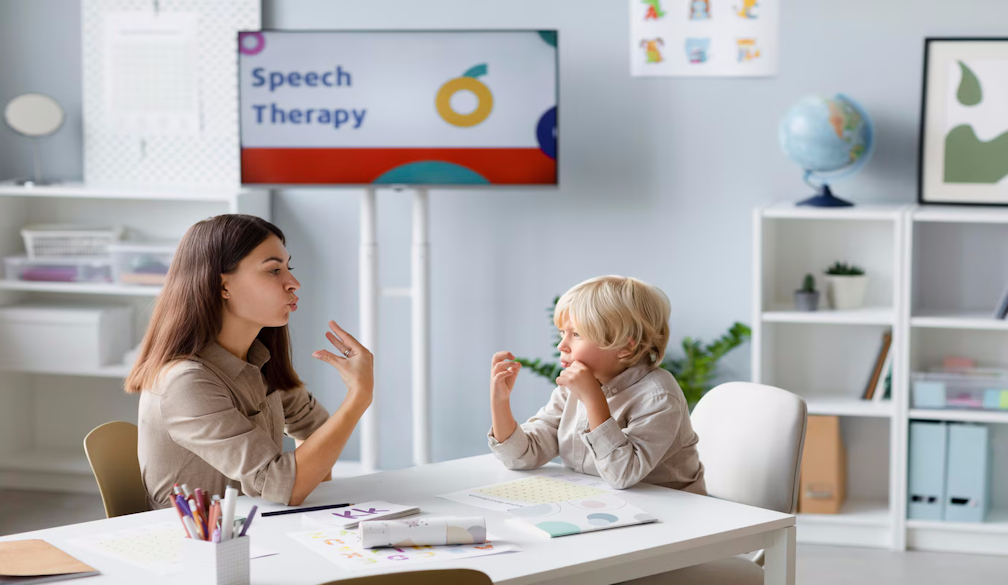The Benefits of Animal-Assisted Speech Therapy For Children

Speech therapy has long been a standard for supporting children’s communication and emotional development. But what happens when you introduce a furry friend into the process? That’s where you get animal-assisted speech therapy (AAST), an evidence-based approach to speech therapy that involves getting a trained therapy animal to accompany you during your sessions.
Whether your child has a speech delay, has trouble communicating, or is just shy about speaking up, having an animal in the room can create a calmer and more interactive atmosphere that encourages them to come out of their shell and enables faster progress. It's not so much about the cute furry snuggles (though those are a definite bonus) — it’s about building trust and confidence while also making communication fun and rewarding.
So, what does that look like in real life? Let's take a closer look at why parents are increasingly turning to AAST in speech pathology clinics in Australia and how it may benefit your child in unexpected ways.
How Animal-Assisted Therapy Helps
Creates a Safe and Relaxed Environment
Many children feel nervous or unsure in clinical settings. Sitting in a room with an adult and being asked to speak can feel like a lot. But having a dog or any other therapy animal in the room can help to change that with the animal acting as a shared point of focus between the therapist and the child, taking the pressure off of the child in having to “perform” or speak.
This relaxed atmosphere makes it easier for children to feel safe, open up, and build bonds with their therapist more quickly. They’re more likely to chat, express themselves, and try new things.
Further studies have also shown that petting a dog — or animals in general — can be valuable for emotional regulation as it can lower anxiety, reduce stress, and increase oxytocin levels — the very same hormone that promotes feelings of love and safety. By helping children redirect their energy and feel emotionally supported, the presence of therapy animals makes it easier for them to focus and participate in learning.
Encourages Social Awareness and Connection
Therapy animals aren’t just a calming presence. They’re an active participant in therapy. For instance, children might be encouraged in speech therapy to talk to the animal, give them instructions, or describe their actions. This is a natural prompt for the child to engage in verbal communication, and some studies on autism have even found this sort of interaction especially beneficial for children with social communication challenges.
Additionally, these animals can also help children understand social cues without the fear of judgment. For instance, a dog might move away if a child is too loud or come closer when they’re calmer. Therapists can point out this behaviour and use the experience to help children think about how what they say and do can affect other people, instead of trying to get children to relate to a fictional scenario using words or pictures.
Promotes Language Through Play
Animal-assisted speech therapy also leans heavily into play-based learning – something that's often crucial for younger children or those with delayed language development. As mentioned earlier, activities like giving commands ("Sit" or “Come here”), describing actions (“He’s wagging his tail”), or storytelling (“What do you think it’ll do next?”) all encourage spontaneous verbalisation in a fun, low-stress environment.
Even routine tasks like brushing the dog or giving it a treat are full of speech opportunities. Children can name objects, explain their actions, and share how they feel. It's a practical, everyday way to build language skills without feeling like hard work.
Boosts Communication Through Participation
One of the most interesting effects seen in animal-assisted speech therapy is what’s known as the “social lubricant effect”. Simply put, animals help conversations flow because they're not people. Children don't feel judged or evaluated in the same way when interacting with them, resulting in less pressure to "get it right" and creating space for more authentic communication to blossom.
In most cases, there also tends to be a strong intrinsic motivation to interact with the animal in a way that doesn’t always translate to adults. Children are typically excited and curious about animals, making them want to talk to or play with them. Using these animals to facilitate therapy can thus ignite a child’s enthusiasm via positive association, making it easier for therapists to maintain engagement with the child and work towards their communication goals.
A Supportive Tool for Children with Autism
If your child is on the autism spectrum, the benefits may feel even more significant. Clinical studies have found that social communication often improves in the presence of animals.
Children who are otherwise withdrawn or resistant to interaction may suddenly become more animated and expressive when a dog is involved. This is because the animal offers a consistent, predictable response — no confusing facial expressions or verbal subtleties to interpret. That reliability can go a long way towards building confidence in their speech and actions.
Why It Works
At its core, AAST works because it’s flexible and child-friendly. It allows children to take the lead, build confidence at their own pace, and learn to speak more fluently in ways that feel natural. The dog or other therapy animal becomes part of the therapy team — supporting learning without adding pressure.
It also allows for individualised learning. No two sessions are the same. A child who thrives on routine might benefit from repetitive tasks involving the animal. Another might engage more with imaginative storytelling or movement-based activities. The therapy animal can thus be woven into the therapy in a seamless and organic way.
Is Animal-Assisted Speech Therapy Right for Your Child?
Every child is different, and speech therapy isn’t a perfect one-size-fits-all approach. But if your child is struggling with speech and social communication while also having anxiety around clinical settings, animal-assisted speech therapy may be worth exploring.
It’s especially helpful for:
- Children with ASD or selective mutism
- Children with general speech and language delays
- Anxious or highly sensitive children
- Those who need help with emotional regulation and confidence.
Just as importantly, it’s a therapy that children often look forward to – which is a rarity in itself.
A Pawprint In The Right Direction
As a parent, it’s natural to want the very best support for your child. Animal-assisted speech therapy isn’t a magic fix, but it’s backed by research and real results, and can be an effective tool in making speech therapy more engaging and less stressful for your kid.
Animal-assisted speech therapy is definitely worth considering for parents looking for a supportive and motivating speech therapy option. It combines proven strategies with the comfort and companionship of a therapy dog – creating a space where children can thrive.

















